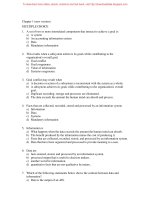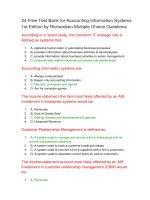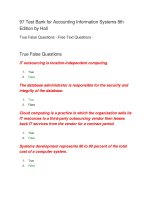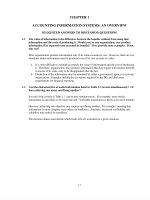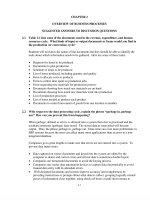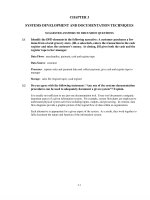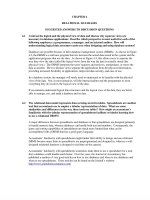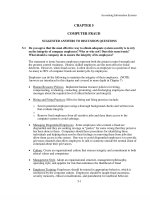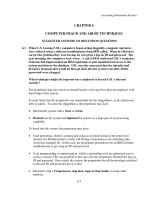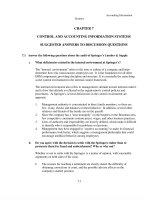Accounting information systems test bank by romney
Bạn đang xem bản rút gọn của tài liệu. Xem và tải ngay bản đầy đủ của tài liệu tại đây (3.04 MB, 249 trang )
To download more slides, ebook, solutions and test bank, visit
Chapter 1 (new version)
MULTIPLE CHOICE
1. A set of two or more interrelated components that interact to achieve a goal is:
a) A system
b) An accounting information system
c) Data
d) Mandatory information
2. This results when a subsystem achieves its goals while contributing to the
organization's overall goal.
a) Goal conflict
b) Goal congruence
c) Value of information
d) Systems congruence
3. Goal conflict may result when
a) A decision or action of a subsystem is inconsistent with the system as a whole.
b) A subsystem achieves its goals while contributing to the organization's overall
goal.
c) Duplicate recording, storage and processes are eliminated.
d) The data exceeds the amount the human mind can absorb and process.
4. Facts that are collected, recorded, stored and processed by an information system
a) Information
b) Data
c) Systems
d) Mandatory information
5. Information is
a) What happens when the data exceeds the amount the human mind can absorb.
b) The benefit produced by the information minus the cost of producing it.
c) Facts that are collected, recorded, stored, and processed by an information system.
d) Data that have been organized and processed to provide meaning to a user.
6. Data are
a) facts entered, stored, and processed by an information system.
b) processed output that is useful to decision makers.
c) another word for information.
d) quantitative facts that are not qualitative by nature.
7. Which of the following statements below shows the contrast between data and
information?
a) Data is the output of an AIS.
To download more slides, ebook, solutions and test bank, visit
b) Information is the primary output of an AIS.
c) Data is more useful in decision-making than information.
d) Data and information are the same.
8. Information is
a) basically the same as data.
b) raw facts about transactions.
c) potentially useful facts when processed in a timely manner.
d) data that has been organized and processed so that it's meaningful.
9. Humans can absorb and process only so much information. Information __________
occurs when those limits are passed.
a) overload
b) excess
c) anxiety
d) discretion
10. The value of information can best be defined as
a) how useful it is to decision makers.
b) the benefits produced by possessing and using the information minus the cost of
producing it.
c) how relevant it is.
d) the extent to which it maximizes the value chain.
11. The benefit produced by the information minus the cost of producing it.
a) Goal congruence
b) Information
c) Information overload
d) Value of information
12. An accounting information system (AIS) processes __________ to provide users with
__________.
a) data; information
b) data; transactions
c) information; data
d) data; benefits
13. How many components are found in an AIS?
a) three
b) four
c) five
d) six
14. An accounting information system in part consists of
To download more slides, ebook, solutions and test bank, visit
a)
b)
c)
d)
People, hardware and programs.
Information, programs and computers.
People, procedures, data, software and information technology infrastructure.
Internal controls and accounting records.
15. Information that reduces uncertainty, improves decision makers' ability to make
predictions, or confirms or corrects their prior expectations, is said to be
a) Complete
b) Relevant
c) Reliable
d) Timely
16. Information that is free from error or bias and accurately represents the events or
activities of the organization is
a) Relevant
b) Reliable
c) Verifiable
d) Timely
17. Information that does not omit important aspects of the underlying events or activities
that it measures is
a) Complete
b) Accessible
c) Relevant
d) Timely
18. When two knowledgeable people acting independently each produce the same
information, this information is said to be
a) Complete
b) Relevant
c) Reliable
d) Verifiable
19. Data must be converted into information to be considered useful and meaningful for
decision-making. There are six characteristics that make information both useful and
meaningful. If information is free from error or bias and accurately represents the
events or activities of the organization, it is representative of the characteristic of
a) Relevancy
b) Timeliness.
c) Understandability
d) Reliability
20. The primary consideration when producing this type of information is that its benefits
exceeds its costs.
a) Discretionary information
b) Essential information
To download more slides, ebook, solutions and test bank, visit
c) Mandatory information
d) Value of information
21. An AIS is a system of six interrelated components that interact to achieve a goal.
One of these components, which includes both manual and automated activities that
involve collecting, processing, and storing data, is known as
a) Information or data
b) Procedures and instructions
c) Software
d) Information technology infrastructure
22. An accounting information system must be able to perform which of the following
tasks?
a) collect transaction data
b) process transaction data
c) provide adequate controls
d) all of the above
23. Which of the following is not an example of a common activity in an AIS?
a) buy and pay for goods and services
b) sell goods and services and collect cash
c) summarize and report results to interested parties
d) recording of sales calls for marketing purposes
24. Which of the following is not one of the components of an AIS?
a) Internal controls and security measures
b) People
c) Procedures and instructions
d) Software and hardware
25. An AIS must be able to fulfill three important functions in any organization. One
such function is the collecting and storing of data about activities performed by the
organization. One group that relies on both the adequate collection and
transformation of data for decision-making purposes for an organization is
a) management.
b) interested outsiders.
c) competitors.
d) the government.
26. The primary objective of accounting is to
a) implement strong internal controls.
b) provide useful information to decision makers.
c) prepare financial statements.
d) ensure the profitability of an organization.
To download more slides, ebook, solutions and test bank, visit
27. The Financial Accounting Standards Board (FASB), in its Statement of Financial
Accounting Concepts No. 2, has defined accounting as
a) an information identification, development, measurement, and communication
process.
b) a way to provide adequate controls to safeguard an organization's assets.
c) being an information system.
d) a way to collect and transform data into useful information.
28. Which activity below would not be considered to be a "top" accountant work
activity?
a) process improvement
b) input into future product marketing initiatives
c) long-term strategic planning
d) computer systems and operations
29. The American Institute of Certified Public Accountants (AICPA) has recognized the
importance of AIS and the major impact information technology has on the area of
accounting. To recognize individual CPAs who have met educational and
experiential requirements in this area, the group formally created the designation
known as
a) the Certified Management Accountant.
b) the Certified Information Technology Professional.
c) the Certified Internal Auditor.
d) the Certified Data Processing Professional.
30. An analysis conducted by the Institute of Management Accountants shows that the
most important activities performed by corporate accountants relate to
a) customer and product profitability.
b) internal consulting.
c) process improvement.
d) accounting systems and financial reporting.
31. The primary focus of an AIS course, as opposed to other IS courses, is on
a) application of information technology.
b) use of accounting software.
c) understanding how information technology can be used to improve AIS
processes.
d) preparation of financial statements.
32. The AIS must include controls to ensure
a) safety and availability of data.
b) marketing initiatives match corporate goals.
c) information produced from data is accurate.
To download more slides, ebook, solutions and test bank, visit
d) both A and C
33. A change in the AIS that makes information more easily accessible and widely
available within an organization is most likely to first influence the
a) organizational culture.
b) customer base.
c) external financial statement users.
d) production activity.
34. The process of creating value for customers is the result of nine activities (five
primary and four support) that taken together form a
a) value chain.
b) profitable operation.
c) successful business.
d) support system.
35. The value chain concept is composed of two types of activities known as
a) primary and support.
b) primary and secondary.
c) support and value.
d) technology and support.
36. Which of the following is a primary activity in the value chain?
a) infrastructure
b) technology
c) purchasing
d) marketing and sales
37. In value chain analysis, what is the activity of arranging the delivery of products to
customers called?
a) outbound logistics
b) inbound logistics
c) shipping
d) delivery
38. An AIS provides value by
a) improving products or services through information that increases quality and
reduces costs.
b) providing timely and reliable information to decision makers.
c) creating new products.
d) both A and B
To download more slides, ebook, solutions and test bank, visit
39. In Chapter 1, Figure 1-2 shows the factors that influence the design of AIS. The
diagram shows a bi-directional arrow between the organizational culture and the AIS.
The reason for this two-way interchange between organizational culture and AIS is
a) that the AIS should not influence the values of the organizational culture.
b) because the organization's culture influences the AIS, and likewise the AIS
influences the organization's culture by controlling the flow of information within
the organization.
c) due to the transfer of managers between the two corporate elements.
d) the AIS impacts the organization's key strategies.
40. The objective of the majority of organizations is to provide value to their customers.
The activities that support such an objective can be conceptualized as forming a value
chain. Within this value chain, logistics plays an important role. Logistics is both
inbound and outbound in nature. An example of inbound logistics would consist of
a) the activities that transform inputs into final products or services.
b) the activities that help customers to buy the organization's products or services.
c) the activities that provide post-sale support to customers.
d) the activities that consist of receiving, storing, and distributing the materials used
as inputs by the organization to create goods and/or services it sells.
41. A good example of how an AIS is used to share knowledge within an organization is
a) the use of an expert system to help staff identify the relevant experts who can help
with a particular client.
b) the use of laptop computers to access a network for messaging worldwide.
c) the monitoring of production equipment to watch for defects.
d) the use of point-of-sale data to determine hot-selling items.
42. Within the value chain conceptual framework, organizations also perform a number
of other support activities that enable the five primary value chain activities to be
performed efficiently and effectively. One such support activity is research and
development. This activity can be identified as a
a) firm infrastructure activity.
b) human resources activity.
c) technology activity.
d) purchasing activity.
43. Within the value chain conceptual framework, AIS is shown as a support activity.
The AIS is of value to an organization when it provides accurate and timely
information to help support the five primary value chain activities. When the AIS
provides information in a timely and accurate manner, it stands as an example of
a) improved decision making.
b) improving the quality and reducing the costs of products or services.
c) improving efficiency.
d) All of the above
To download more slides, ebook, solutions and test bank, visit
44. A decision situation that is non-routine and for which no established framework exists
for making the decision is called a(n) __________ decision.
a) structured
b) semistructured
c) unstructured
d) strategic
45. A decision that is repetitive, routine and well understood is
a) structured
b) semistructured
c) unstructured
d) strategic
46. Which of the following is an example of a strategic planning decision?
a) setting financial and accounting policies
b) conducting a performance evaluation
c) budgeting
d) developing human resource practices
47. Decisions about the effective and efficient execution of specific tasks are concerned
with
a) operational control.
b) management control.
c) strategic planning.
d) tactical planning.
48. Budgeting and human resource practices are examples of
a) operational control
b) management control
c) strategic planning
d) tactical planning
49. Accounting information plays major roles in managerial decision making by
a) identifying situations requiring management action.
b) reducing uncertainty.
c) providing a basis for choosing among alternative actions.
d) all of the above
50. Business activities that pertain to product pricing, discount and credit terms, and
identifying the most and least profitable items are part of the __________ activity in
the organization's value chain.
a) service
b) marketing and sales
To download more slides, ebook, solutions and test bank, visit
c) operations
d) inbound logistics
51. A principal focus of AIS is to assist with the decision-making function of an
organization. The degree of support AIS can provide depends on the type of decision
being made. Decisions are categorized in terms of the degree of existing structure or
the effect of their scope. From the items below, select the description that is an
example of a semi-structured decision.
a) selecting basic research projects to undertake
b) setting a marketing budget for a new product
c) extending credit to an established customer
d) hiring a senior manager
52. Regarding decision scope, which statement below is true?
a) Operational control is concerned with the effective and efficient use of resources
for accomplishing organizational objectives.
b) Management control is concerned with the effective and efficient performance of
specific tasks.
c) Strategic planning is concerned with establishing organizational objectives and
policies for accomplishing those objectives.
d) There is no real correlation between a manager's level in an organization and his
or her decision-making responsibilities.
53. A well-designed AIS can improve the decision-making function within the
organization. Which statement below would describe a limitation, rather than a
benefit, of an efficient AIS?
a) An AIS reduces uncertainty, and therefore accounting information can provide a
basis for choosing among alternative courses of action.
b) An AIS identifies situations requiring management action.
c) An AIS provides to its users an abundance of information without any filtering or
condensing of such information.
d) An AIS provides information about the results of previous decisions which
provides decision makers with feedback that can be used in future decision
making.
54. A strategic position is important to the success and growth of any organization.
Harvard professor Michael Porter has identified three basic strategic positions.
Which statement below is false regarding these basic strategic positions?
a) The three basic strategic positions are mutually exclusive of each other.
b) Part of a needs-based strategic position is to identify a target market.
c) An access-based strategic position involves serving a subset of customers who
differ from other customers in terms of geographic location or size.
d) A variety-based strategic position involves producing or providing a subset of the
industry's products or services.
To download more slides, ebook, solutions and test bank, visit
55. A strategic position is important to the success and growth of any organization.
Harvard professor Michael Porter has identified two basic business strategies. Which
statement below is false regarding these basic strategies?
a) A product differentiation strategy entails adding features or services not provided
by competitors to a product so customers can be charged a premium price.
b) A low-cost strategy entails striving to be the most efficient producer of a product
or service.
c) Sometimes a company can succeed in both producing a better product and
achieving low costs.
d) The two basic strategic positions are mutually exclusive.
56. According to Michael Porter, to be successful in the long run, a company must
a) deliver greater value to customers and/or create comparable value at a lower cost.
b) maximize profits.
c) maximize shareholder value.
d) both B and C
57. A variety-based strategic position involves
a) trying to serve most or all of the needs of a particular group of customers.
b) serving a subset of customers who differ from other customers.
c) providing a subset of the industry's products or services.
d) serving all needs of all customers.
58. A needs-based strategic position involves
a) trying to serve most or all of the needs of a particular group of customers.
b) serving a subset of customers who differ from other customers.
c) providing a subset of the industry's products or services.
d) serving all needs of all customers.
59. An access-based strategic position involves
a) trying to serve most or all of the needs of a particular group of customers.
b) serving a subset of customers who differ from other customers.
c) providing a subset of the industry's products or services.
d) serving all needs of all customers.
60. The Internet has changed the way many processes are performed in business today.
The Internet has had a material effect on the five primary characteristics in the value
chain and on the strategy adopted by businesses that incorporate use of the Web into
their business systems. Which statement below is true regarding the Internet relative
to a strategic position that a business may adopt?
a) Use of the Internet has reduced the power of buyers.
b) The Internet has increased the barriers to entry in many industries.
c) Use of the Internet reduces pressure to compete on price.
d) The most important effect of the development of the Internet in business is the
increased importance of adopting a viable business strategy.
To download more slides, ebook, solutions and test bank, visit
SHORT ANSWER
61. Define the concept of a system.
62. Define data, information, and how the value of information is determined.
63. Define an accounting information system.
64. Identify the components of an accounting information system.
65. What is the CITP designation and why is it important to AIS?
66. Differentiate between an AIS course and other accounting courses.
67. Harvard professor Michael Porter contends that for a company to be successful in the
long run it "must deliver greater value to customers or create comparable value at a
lower cost, or do both" and suggests three strategic positions. Describe these strategic
positions. How do these strategic positions relate to financial and managerial
accounting information given?
68. What is the purpose behind the five primary activities in the value chain?
69. Name the primary activities of a firm's value chain.
70. How can an AIS add value to the organization?
71. How can a well-designed AIS improve the efficiency and effectiveness of a
company's value chain?
ESSAY
72. Discuss the concept of a system and the issues of goal conflict and goal congruence.
73. Discuss the seven characteristics of useful information.
74. Explain what an AIS is, describe the basic tasks it performs in an organization, and
give some examples of the types of accounting transactions it processes.
75. Discuss the steps in the supply chain.
76. How can an AIS become part of the firm's value chain and add value to the business?
77. How can the value of the information produced by an accounting information system
be determined? What would a measurement and verification expert think about
quantification and verification of such information?
To download more slides, ebook, solutions and test bank, visit
ANSWER KEY
1. A
2. B
3. A
4. B
5. D
6. A
7. B
8. D
9. A
10. B
11. D
12. A
13. D
14. C
15. B
16. B
17. A
18. D
19. D
20. A
21. B
22. D
23. D
24. D
25. A
26. B
27. C
28. B
29. B
30. D
31. C
To download more slides, ebook, solutions and test bank, visit
32. D
33. A
34. A
35. A
36. D
37. A
38. D
39. B
40. D
41. A
42. C
43. D
44. C
45. A
46. A
47. A
48. B
49. D
50. B
51. B
52. C
53. C
54. A
55. D
56. A
57. C
58. A
59. B
60. D
To download more slides, ebook, solutions and test bank, visit
61. A system is a set of two or more components that are somehow interrelated and
interact together to achieve a specific goal.
62. Data: facts that are collected, entered, recorded, stored, and processed by an AIS.
Information: data that has been organized and processed and is meaningful to its
users. Such information is relevant, timely, reliable, verifiable, complete, and
understandable. Information is of value when the benefits received from using or
acting upon it outweighs the cost to produce the information.
63. An AIS is a system that collects, records, stores, and processes data to produce
information for decision makers. An AIS is a valuable tool when integrated with the
strategic planning initiatives of an organization.
64. A well-designed AIS consists of people, procedures and instructions, data, software,
information technology infrastructure, and internal controls and security measures.
65. The CITP designation stands for "Certified Information Technology Professional." It
is awarded to CPAs who have demonstrated a broad range of knowledge and skill sets
in the areas of accounting and information systems and technology. The AICPA
(American Institute of CPAs) has acknowledged the importance and close
relationship that accounting and information systems share in creating this specialty
designation for accounting information system professionals.
66. Other accounting courses assume the preparation or reporting of accounting
information is for external or internal users. However, the AIS course focuses on the
flow of accounting information in the organization from a systems perspective. The
AIS course traces the origin, processing, storing, and ultimate disposal of
information. An AIS course also focuses on business processes, organization
structure, information systems, and corporate planning and goals.
67. The three strategic positions described are: a) a variety-based strategic position that
involves producing or providing a subset of the industry's products or services; b) a
needs-based strategic position that involves trying to serve most or all of the needs of
a particular group of customers; and c) an access-based strategic position that
involves serving a subset of customers who differ from other customers in terms of
factors such as geographic location or size which create different requirements for
serving those customers. AIS that has been properly designed can support an
organization in attaining and maintaining a strategic position. Such an information
system can be a valuable asset in helping the organization to maintain a competitive
position in the marketplace.
68. The goal of the five primary activities in the value chain is to facilitate the business in
providing value to its customers. The five primary activities allow the business to
create, market, and deliver its products and services to its customers, as well as
providing postsale support.
69. Inbound logistics, operations, outbound logistics, marketing and sales, and service.
70. An AIS can increase the efficiency and effectiveness of the value chain by improving
the quality and lowering costs of products or services, improving efficiency of
operations, improving decision making, enhancing the sharing of knowledge,
To download more slides, ebook, solutions and test bank, visit
improving the efficiency and effectiveness of its supply chain and improving the
internal control structure.
71. The AIS can be designed to allow customers direct access to a company's inventory
and sales order entry systems. This allows the customer to do more of the work that
traditionally has been done by sales, marketing, and administration personnel. This
allows for faster ordering, and cuts the company’s labor costs. It may also have the
effect of allowing the customer more control in a purchase transaction that may bring
more satisfaction and value to the customer.
72. A system is a set of two or more components that are somehow interrelated and
interact together to achieve a specific goal. A system usually consists of smaller
components called subsystems. These subsystems have specific and defined
functions, which interact with and support the larger system. The concept of systems
is key to information technology and AIS. All systems, including the AIS, must work
to achieve one or more organizational goals. Goal conflict results when a decision or
action of a subsystem is inconsistent with another subsystem or the system
(organization) as a whole. Goal congruence results when a subsystem achieves its
goals while contributing to the organization's overall goal. Subsystems should
maximize organizational goals.
73. The seven characteristics of useful information are: relevant, reliable, complete,
timely, understandable, verifiable and accessible. These characteristics are qualities
that information should possess to be useful in a business environment. Briefly
stated, in order for information to be useful it must be: 1) relevant, meaning that it
reduces uncertainty and adds to the decision-making process; 2) reliable information
is information that is free from error, and is accurate in its nature; 3) complete
information is information that does not omit any important data, facts, or aspects
about events or activities; 4) information is timely when it is fully available to enable
the decision-making process to proceed; 5) understandable information must be both
in an intelligible and useful format; 6) information is considered verifiable if two
people, acting independently of each other, produce the same information or the same
results. Information is accessible if it is available to users when they need it and in a
format they can use.
74. An AIS consists of six components: people, procedures, instructions, data, software,
and information technology infrastructure and internal controls and security
measures. The AIS performs three major functions: 1) it collects and stores data
about activities and transactions so that the organization's management, employees,
and interested outsiders can review what has happened; 2) the AIS processes data
(that is, facts that have been collected and stored) into information that is useful for
making decisions, and is of value to the organization; and 3) the AIS provides
adequate controls designed to safeguard the organization's assets, including its data
and information. Common examples of accounting transactions that an AIS helps to
process and track are the sales of products to customers, cash collections, cash
payments, and the recording and payment of the employees' payroll.
To download more slides, ebook, solutions and test bank, visit
75. The supply chain shows how an organization interacts with suppliers, distributors,
and customers to provide value in the products it sells. The supply chain depicts the
creation and sale of a product-the chain is somewhat different when a service is
involved. The supply chain has five components: raw materials; manufacturer;
distributor; retailer; and the consumer. Raw materials come from any number of
suppliers, which in turn become part of a manufacturing process, which produces a
product. The business then provides the product to distributors, who in turn sell the
product to retail businesses. The product is ultimately purchased and used by
consumers (who may be individuals or businesses). It is important to realize that AIS
can greatly impact the traditional supply chain by creating a more efficient and timely
environment in which a business can operate. More efficient operations are more
effective, which in turn lowers costs, and add greater value and create improved
customer satisfaction.
76. The AIS can add value by: helping to improve products and services an organization
offers for sale; increasing the quality of products and services; creating greater
efficiency by reducing costs and saving time; and improving the overall efficiency of
the organization. Decision making is enhanced by the better availability of timely,
complete, reliable, verifiable, and relevant information. A firm can enjoy a
competitive advantage with better customer ordering, billing, and customer service
made possible by an improved AIS. The AIS can also enhance overall
communication and use of knowledge in a business by making the knowledge readily
available to interested parties.
77. A well-designed AIS improves the efficiency and effectiveness of the value chain by
improving the quality and lowering the overall cost of products or services,
improving efficiency of operations, improving decision making, and enhancing the
sharing of knowledge. These are the benefits of possessing and using information.
Drawbacks to possessing and using such information are the costs of obtaining and
maintaining such information. These costs include investments in people, processes,
and computing and networking hardware and software on an ongoing basis. Costs of
the information are quantifiable to some extent. However, some of the benefits of
using the information involve numerous estimates and assumptions. As such, the
quantification of the benefits of utilizing such information depends on the accuracy of
the assumptions.
To download more slides, ebook, solutions and test bank, visit
Chapter 2 (new version)
MULTIPLE CHOICE
1. An agreement between two entities to exchange goods or services or any other event
that can be measured in economic terms by an organization is
a) give-get exchange
b) transaction
c) revenue
d) processing cycle
2. Groups of related business activities such as the acquisition of merchandise and
payment of vendors are called
a) transaction cycles.
b) economic cycles.
c) business events.
d) transactions.
3. The transaction cycles approach leads to efficient processing of large number of
transactions because
a) transaction cycles are easier to computerize.
b) a large number of transactions within a given cycle can be categorized into a
relatively small number of distinct types.
c) the transaction cycle approach represents the natural order of business.
d) transaction cycles are easy to understand.
4. The basic "give and take" functions of a business have been grouped into transaction
cycles. The cycle that includes the events of hiring employees and paying them is
known as the
a) revenue cycle.
b) expenditure cycle.
c) human resources cycle.
d) financing cycle.
5. What is the major difference between the revenue and the expenditure cycle?
a) The revenue cycle includes marketing activities; the expenditure cycle does not.
b) In the revenue cycle, cash is received; in the expenditure cycle cash is paid out.
c) The expenditure cycle includes paying employees.
d) The revenue cycle includes the activity of obtaining funds from investors.
6. The business owners obtain financing from outside investors, which results in an
inflow of cash into the company. This transaction is considered to be part of which
cycle?
a) the revenue cycle
b) the payroll cycle
c) the production cycle
d) the financing cycle
To download more slides, ebook, solutions and test bank, visit
7. Which of the following is not a transaction cycle?
a) revenue
b) expenditure
c) human resources
d) general ledger and reporting
8. All transaction cycles feed information directly into the
a) financial statements.
b) governmental reports.
c) general ledger and reporting system.
d) financing operations.
9. Transaction cycles can be summarized on a high level as "give-get" transactions. An
example of "give-get" in the expenditure cycle would be
a) give cash, get cash.
b) give cash, get goods.
c) give cash, get labor.
d) give goods, get cash.
10. Transaction cycles can be summarized on a high level as "give-get" transactions. An
example of "give-get" in the revenue cycle would be
a) give cash, get goods.
b) give goods, get cash.
c) give cash, get labor.
d) give cash, get cash.
11. The transaction cycles relate to one another and interface with this to generate
information for both management and external parties.
a) general ledger and reporting system
b) accounting information systems
c) computer processor
d) human resources cycle
12. Many modern accounting software packages offer separate transaction cycle modules.
What is the reason for this?
a) Every organization does not need to implement all of the available transaction
cycle modules.
b) Most businesses do not need the revenue cycle module as part of their AIS.
c) The nature of a given transaction cycle is the same irrespective of the type of
organization.
d) A properly designed AIS does not use the concept of separate business transaction
cycles to process transactions.
13. Which of the following statements is false?
a) Retail stores do not have a production cycle.
To download more slides, ebook, solutions and test bank, visit
b) Financial institutions have installment-loan cycles.
c) A service company does not have an inventory system.
d) Every organization should implement every transaction cycle module.
14. The operations performed on data to generate meaningful and relevant information
are referred to as
a) general ledger and reporting system
b) accounting information system
c) financial reporting
d) data processing cycle
15. One of the steps in the data processing cycle is data input. What is the catalyst for
data input into a system?
a) The production transaction system automatically checks each hour to see if any
new data is available for input and processing.
b) The performance of some business activity generally serves as the trigger for data
input.
c) A general ledger program is queried to produce a trial balance at the end of an
accounting period.
d) Data is only input when an authorized party permits the input to occur.
16. A typical source document could be
a) in some paper form.
b) a computer data entry screen.
c) a notepad entry.
d) both A and B
17. Which step below is not considered to be part of the data processing cycle?
a) data input
b) feedback from external sources
c) data storage
d) data processing
18. Data must be collected about three facets of each business activity. What are they?
a) the business activity, the resources it affects, the people who participate
b) the business activity, the transactions it creates, the impact on the financial
statements
c) the inputs, outputs and processes used
d) who is involved, what was sold, how much was paid
19. Certain documents or forms are generated and/or processed with each transaction
cycle. The issuing of a purchase order is part of which transaction cycle?
a) the revenue cycle
b) the production cycle
c) the human resources cycle
d) the expenditure cycle
To download more slides, ebook, solutions and test bank, visit
20. Certain documents or forms are generated and/or processed with each transaction
cycle. The collection of job time tickets or time sheets is part of which transaction
cycle?
a) the revenue cycle
b) the production cycle
c) the human resources cycle
d) the expenditure cycle
21. Common source documents for the revenue cycle include all of the following except
a) sales order.
b) receiving report.
c) delivery ticket.
d) credit memo.
22. Which of the following documents would be found in the expenditure cycle?
a) delivery ticket
b) time card
c) journal voucher
d) purchase order
23. Businesses usually use some type of documents in the data input step of the data
processing cycle. Documents that are sent to customers or suppliers and then sent
back to the organization in the course of a business transaction are known as
a) turnaround documents.
b) source documents.
c) source data automation.
d) rubber or bounce-back documents.
24. What is a primary example of source data automation?
a) a utility bill
b) POS (point-of-sale) scanners in retail stores
c) a bill of lading
d) a subsidiary ledger
25. Pre-numbering of source documents helps to verify that
a) all transactions have been recorded since the numerical sequence serves as a
control.
b) no inventory has been misplaced.
c) documents have been used in order.
d) all cash has been collected.
26. Source documents generally help to improve accuracy in transaction processing
because
a) they specify which information to collect due to their structure.
b) standard information is preprinted on the document.
To download more slides, ebook, solutions and test bank, visit
c) they provide directions and steps for completing the form.
d) All of the above are correct.
27. When the sum of all entries in the subsidiary ledger equals the amount in the
corresponding general ledger account, it is assumed that (select all that apply)
a) the recording and posting processes are accurate.
b) all of the transaction cycles have been completed.
c) since the ledgers are in balance, adjusting entries are not required.
d) no errors exist in the subsidiary ledger and corresponding general ledger account.
28. The general ledger account that corresponds to a subsidiary ledger account is known
as a
a) dependent account.
b) attribute account.
c) entity account.
d) control account.
29. The systematic assignment of numbers or letters to items to classify and organize
them is known as
a) coding
b) chart of accounts
c) data input
d) pre-numbered documents
30. Pre-numbered checks, invoices and purchase orders are examples of
a) sequence codes
b) block codes
c) group codes
d) hierarchical codes
31. A chart of accounts is an example of (select all that apply)
a) sequence codes
b) block codes
c) group codes
d) hierarchical codes
32. Inventory items are often codes with these
a) sequence codes
b) block codes
c) group codes
d) hierarchical codes
33. A listing of general ledger accounts by account number is called the
a) chart of accounts.
b) listing of accounts.
c) trial balance.
To download more slides, ebook, solutions and test bank, visit
d) subsidiary accounts.
34. Regarding codes, which of the following is false?
a) The code should be consistent with its intended use.
b) Codes should allow for growth in the number of items to be coded.
c) Coding systems should be as simple as possible.
d) Coding systems need not be consistent across divisions of an organization.
35. To be effective, the chart of accounts must
a) be as concise as possible.
b) contain only five account categories.
c) limit account codes to 10 digits or less.
d) contain sufficient detail to meet the information needs of the specific
organization's AIS.
36. The chart of accounts for a manufacturing corporation would include
a) retained earnings.
b) common stock.
c) raw materials inventory.
d) all of the above
37. The chart of accounts of a corporate retail bookstore would probably include
a) work-in-process inventory.
b) a drawing account.
c) retained earnings.
d) both A and C
38. In a chart of accounts using three digits for each account, each numeric digit has
meaning to users of the AIS. For example, a numeric digit may represent either a
major category of accounts, a primary financial subaccount within each category, or a
specific account into which transaction data will be posted. Using this example,
which digit position would best represent a primary financial subaccount within an
account category?
a) first
b) second
c) third
d) fourth
39. In transaction processing, generally which activity comes first?
a) recording data in a journal
b) posting items to special journals
c) capturing data on source documents
d) posting data to a ledger
To download more slides, ebook, solutions and test bank, visit
40. The efficiency of recording numerous business transactions can be best improved by
the use of
a) prenumbered source documents.
b) specialized journals.
c) posting references.
d) segregation of duties.
41. A general journal
a) is used to record infrequent or non-routine transactions.
b) simplifies the process of recording large numbers of repetitive transactions.
c) records all detailed data for any general ledger account that has individual subaccounts.
d) contains summary-level data for every account of the organization.
42. The general ledger
a) is used to record infrequent or non-routine transactions.
b) simplifies the process of recoding large numbers of repetitive transactions.
c) records all detailed data for any general ledger account that has individual subaccounts.
d) contains summary-level data for every account of the organization.
43. A subsidiary ledger
a) is used to record infrequent or non-routine transactions.
b) simplifies the process of recoding large numbers of repetitive transactions.
c) records all detailed data for any general ledger account that has individual subaccounts.
d) contains summary-level data for every account of the organization.
44. A specialized journal
a) is used to record infrequent or non-routine transactions.
b) simplifies the process of recording large numbers of repetitive transactions.
c) records all detailed data for any general ledger account that has individual subaccounts.
d) contains summary-level data for every account of the organization.
45. An audit trail
a) provides the means to check the accuracy and validity of ledger postings.
b) is provided by the ledger and the general journal.
c) is automatically created in every computer-based information system.
d) is a characteristic of interest.
46. Something about which information is stored is
a) attribute
b) database
c) entity
d) record
To download more slides, ebook, solutions and test bank, visit
47. Characteristics of interest that need to be stored are
a) attribute
b) database
c) entity
d) record
48. Computers store data by organizing smaller units of data into larger units, which have
meaning to users. Data values that are stored in a physical space are called a
a) field.
b) record.
c) file.
d) database.
49. Related records grouped together form a(n)
a) field.
b) entity.
c) file.
d) database.
50. The set of fields that contain data about various attributes of the same entity forms a
a) entity
b) record.
c) file.
d) database.
51. Concerning a master file, which of the following statements is false?
a) It is conceptually similar to a ledger in a manual AIS.
b) It stores cumulative information about an organization's resources.
c) It exists across fiscal periods.
d) Its individual records are not changed.
52. Basic data storage concepts define both entities and attributes. An entity is something
about which information is stored. Which item below would not be considered an
entity?
a) a customer address
b) a customer
c) an employee
d) an inventory item
53. Which of the following is conceptually similar to a journal in a manual AIS?
a) database
b) master file
c) record
d) transaction file
To download more slides, ebook, solutions and test bank, visit
54. Which of the following is not one of the four types of file processing?
a) changing
b) updating
c) deleting
d) altering
55. Periodic updating of the data stored about resources and agents is
a) On-line processing
b) real-time processing
c) batch processing
d) data processing
56. Concerning processing, which of the following statements is true?
a) Batch processing ensures that stored information is always current.
b) Batch input is more accurate than on-line data entry.
c) On-line batch processing is a combination of real-time and batch processing.
d) Batch processing is almost never used.
57. Federal Express stated in one of its mission statements that "positive control of each
package will be maintained by utilizing . . . electronic tracking and tracing systems."
This is an example of which type of data processing?
a) real-time processing which features immediate updating as to the location of
packages
b) batch processing which features updating at fixed time periods
c) real-time processing which features updating at fixed time periods such as at the
end of an accounting period
d) batch processing which features immediate updating as to the location of
packages
58. Documents generated at the end of transaction processing activities are called
a) financial statements
b) operational documents
c) reports
d) source documents
59. Which of the following is not a type of report provided to decision makers by the
typical AIS?
a) financial statements
b) customer satisfaction surveys conducted by third parties
c) managerial reports
d) All of the above reports are important to decision makers.
60. Which statement below regarding the AIS and managerial reports is false
a) The AIS must be able to provide managers with detailed and operational
information about the organization's performance.
